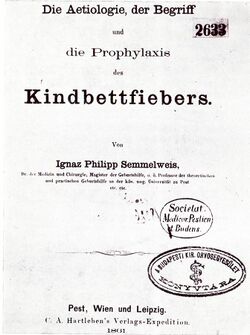Medicine:Etiology, Concept and Prophylaxis of Childbed Fever
Etiology, Concept and Prophylaxis of Childbed Fever (German: Die Ätiologie, der Begriff und die Prophylaxis des Kindbettfiebers) is a pioneering medical book by Ignaz Semmelweis published in 1861, which explains how hygiene in hospitals can drastically reduce unnecessary deaths. The book and concept saved millions of mothers from a preventable, streptococcal infection.[citation needed]
The book is 524 pages total and it is claimed to be one of the most comprehensive medical studies ever published. It includes studies in hospitals conducted in Vienna in 1847, and was translated into English by Kay Codell Carter in 1983.
Semmelweis's findings challenged conventional ideas about the incidence of puerperal fever (also known as postpartum infections or childbed fever), finding that it could be drastically reduced by requiring hand disinfection in obstetrical clinics. He also cites bed hygiene by washing linens after each patient.
Puerperal fever was a deadly infection, common in mid-19th-century hospitals. Semmelweis proposed the practice of washing hands with chlorinated lime solutions in 1847 while working in Vienna General Hospital's First Obstetrical Clinic, where doctors' wards had three times the mortality of midwives' wards.[1]
Semmelweis had his life ruined at the time of publication because his ideas, though now proved and trusted, seemed impossible. The book contains a 100 page section purely dedicated to disproving many of the claims his critics had made about his research and ideas. Due to said critique, Semmelweis’s personal life fell apart, leading to behavioral issues and his eventual death.[citation needed]
Despite this, in today's world Semmelweis is described as the "saviour of mothers."[2]
See also
- Ignaz Semmelweis
References
Works cited
- Semmelweis Society International. "Dr Semmelweis' Biography". http://semmelweis.org/about/dr-semmelweis-biography/.
- Hanninen, O.; Farago, M.; Monos, E. (September–October 1983), "Ignaz Philipp Semmelweis, the prophet of bacteriology", Infection Control 4 (5): 367–370, doi:10.1017/S0195941700059762, PMID 6354955, http://www.general-anaesthesia.com/semmelweis.htm, retrieved October 26, 2009, "Only the clinical facts proved him right during his lifetime; the triumph of bacteriology which began after his death made him not only the "savior of mothers" but also a genial ancestor of bacteriology."
External links
 |


